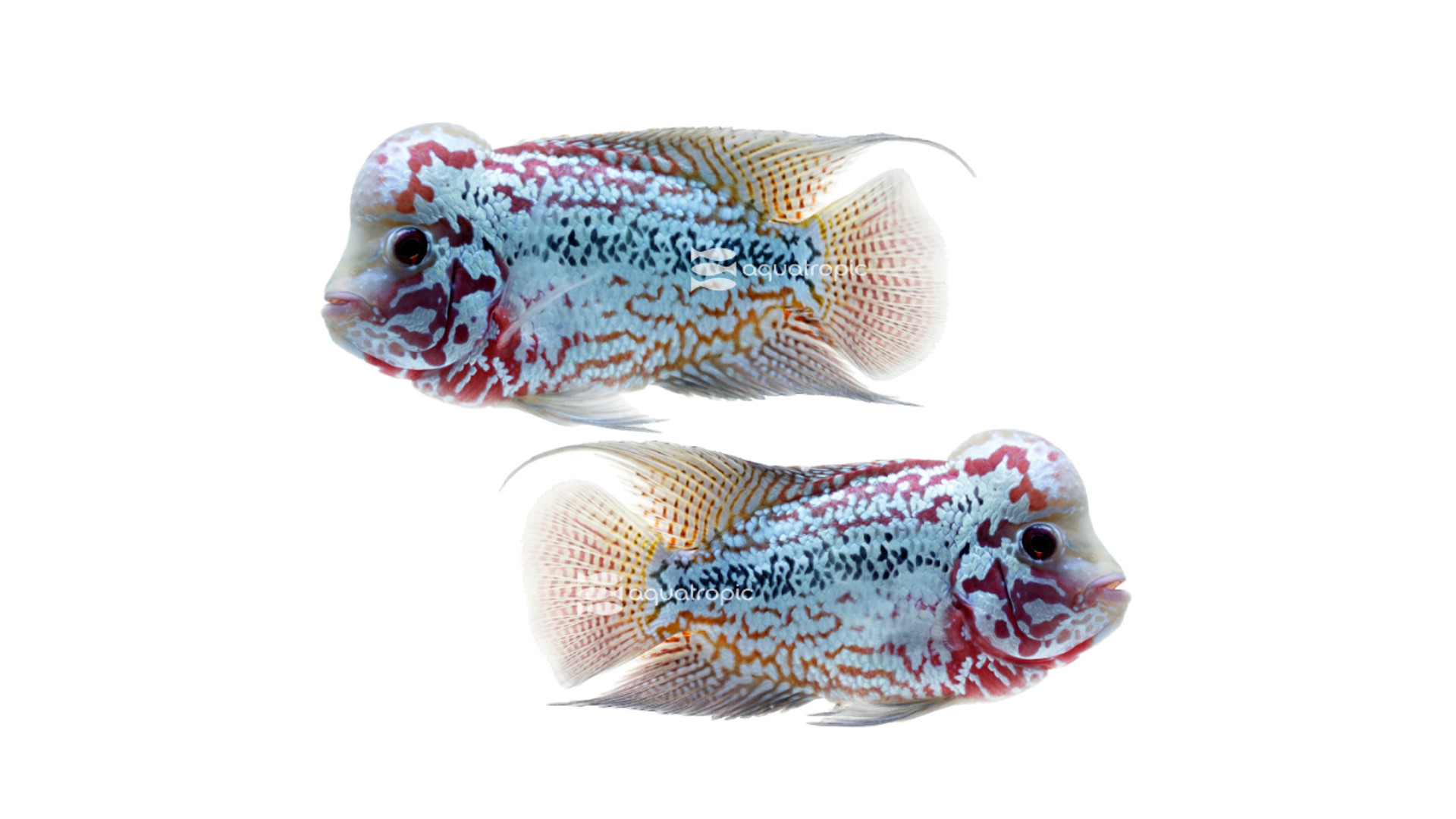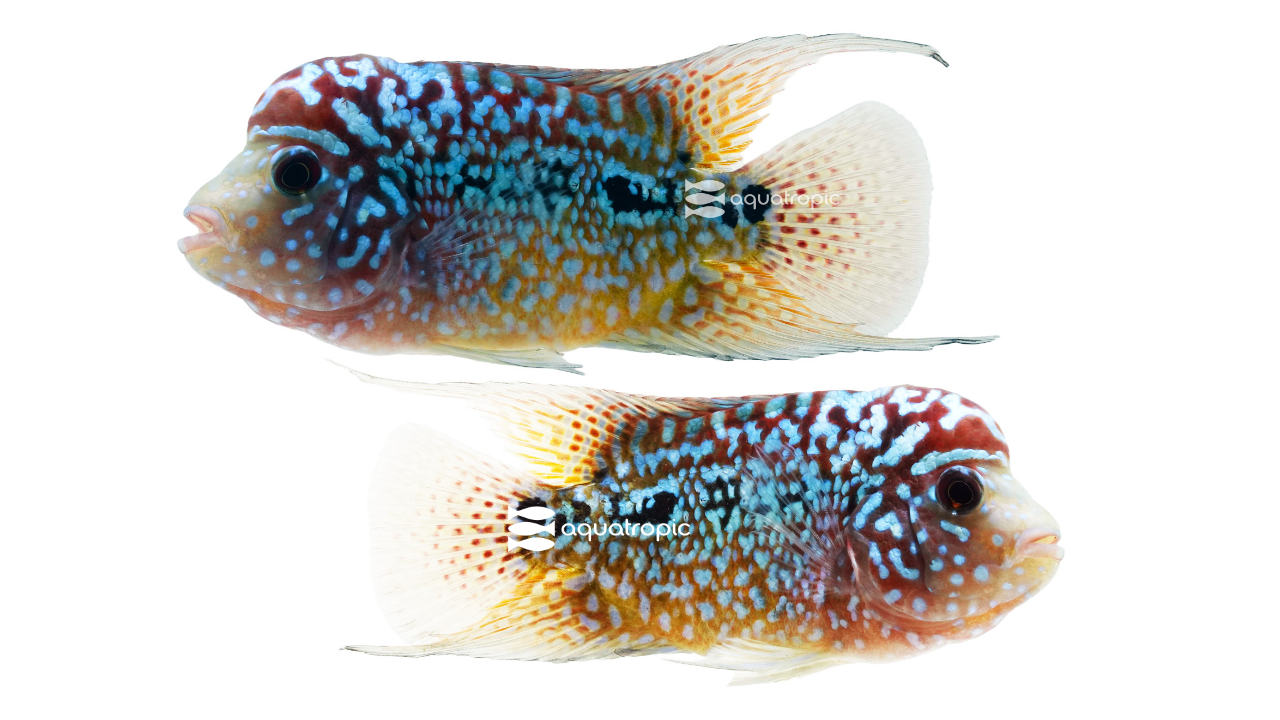King Kamfa Of The Flowerhorns

The Kamfa Flowerhorn Cichlid is a hybridized cichlid, likely from Banded Cichlids (Heros severus) and Redhead Cichlid (Vieja synspilum). Flowerhorn Cichlids are a group of fish that are bred for their appearance and outgoing demeanor, by hybridizing the aggressive and colorful cichlids of Central America which can interbreed with viable offspring – unlike most South American cichlids which cannot. Vieja or Redhead cichlids are truly a rainbow fish – a red head, blue body, and a yellow tail with some mixing and black spots – they are one of the more unique looking fish to be found in freshwaters. A larger cichlid, Redheads might get to be as big as 14 inches! Banded Cichlids are a little blander by comparison but come in a variety of different color morphs. The wild form is a cream colored fish with dark vertical bands, a gray head, and a red pelvic/pectoral area. These fish reach about eight inches in total length and live at least five to ten years. The Kamfa Flowerhorn have a unique set of standards that set them apart from others, and reach a length of about 10 to 12 inches.
While there is no “native range” for Kamfa Flowerhorns since they only exist in our aquariums, we can discuss what the range and habitat is for the species that comprise their genetics. Vieja or Redhead cichlids are found in the Usumacinta River drainage in Mexico, Guatemala and Belize. They prefer slower moving waters such as pools, backwaters or slower flowing areas in rivers, and even sometimes in slightly brackish waters of estuaries as these rivers approach the ocean. Banded Cichlids are from Northern South America. They are found in the Orinoco, Amazon, and Negro River basins. These fish also prefer slower moving waters, such as oxbows, river floodplains, and some brackish estuaries. They are generally found in deeper water with taller, vertical vegetation which makes sense with the vertical baring coloration that they display – it’s the perfect camouflage for such an environment.
The proper size aquarium for Flowerhorns can vary. They can be kept in smaller aquariums, so long as you are ready to upgrade before they need additional space. Tiny ones of an inch or two can be kept in aquariums as small as twenty gallons, potentially even ten gallons if smaller. Three to four inch fish should be upgraded to about 40 gallons, and fish beyond five to six inches should be housed in an aquarium of 55 to 75 gallons as a minimum for a single fish.
As far as water quality goes, Kamfa Flowerhorns are fairly sensitive. As such its best to keep ammonia, nitrite, and nitrate as low as possible. This is best achieved by only adding Kamfas to aquariums that have been cycled, have powerful filtration. We recommend doing frequent partial water changes. Flowerhorns are generally kept in water that is warmer than your average tropical aquarium which usually stays at 78 to 80 degrees Fahrenheit. These cichlids are mostly kept above 80, and generally between 82 and 85 degrees Fahrenheit.
Kamfas have strong, stout bodies and are fine in higher flow levels – aim for at least four times the aquarium volume to be circulated through the filtration system per hour at a minimum. Widespread flow, such as what comes out of a spray bar is ideal for Kamfa Flowerhorns and can help keep left over food and waste off the bottom of the aquarium and allow it to be removed by the filtration system. Substrate has been a controversial subject in the world of Flowerhorns. Fish that excrete a lot of waste like Flowerhorns and prefer warm temperatures mean you want to make sure there are as few places as possible to trap waste (which can steal oxygen, an effect exacerbated by warm water temps). As a result, some people choose to go with a bare bottom setup because nothing is there to catch the waste and waste is easily seen and thus easily removed during weekly water changes. Substrate should either be fine enough that it wont damage your Kamfa Flowerhorn if it accidently ingests it, or big enough that it cant be ingested. Don’t take any chances here, you would hate to lose a fish over a piece of gravel that you could have chosen to not add to the aquarium in the first place. Decorations are fine, but Flowerhorns are boisterous fish, and will absolutely move things around or uproot plants, so plants should either be fake, or very hardy things that can be attached to larger objects such as growing anubias on driftwood or rocks.
Kamfa Flowerhorns are not picky eaters, but advanced Flowerhorn keepers (of any sort) usually feed a specific diet to encourage the deepest, most vibrant colors. Foods containing astaxanthin promotes red and orange coloration in fishes and so foods that include it should be considered at least a supplementary role to bring out the best in your Kamfas. Xanthophyll promotes yellow colors, and while harder to find in Flowerhorn foods it is common in dried egg and marigold powder which could be made into a custom diet. Spirulina is common and easy to find even in health food stores. It promotes blue colors. Young Kamfas should have a diet higher in protein, potentially up to 50%. As they grow, Kamfas between four and six inches should ingest less protein as their growth slows, down to 30 percent. Other natural foods like krill from Gamma Foods can be special treats for Flowerhorns, and also encourage health and positive coloration. A final note on coloration, not related to food is that natural sunlight is widely regarded as a great color enhancer for aquarium fish – so having some indirect sunlight on the aquarium might help to bring out the very best.
Breeding Kamfa Flowerhorns could be an entire article on its own, but generally you first need a male and female fish. Males grow faster and to a larger size, and while many female fish have accentuated hump heads called nuchal humps or “kok” in Flowerhorn terminology males are generally larger. Female can also start to lay eggs in the first year of life. There are plenty of articles that can help further differentiate male and female Flowerhorns. Flowerhorns are almost always kept separately. Introduce the fish carefully, and have a divider in the tank in case it goes poorly. Oftentimes allowing the fish to see one another without being able to reach one another can acclimate them to the others presence. Fish should be well feed and conditioned prior to spawning as the process can be stressful and result in the fish not eating for a couple weeks! Young Flowerhorn are small and will benefit from the addition of live baby brine shrimp as a food source until they are large enough to start taking other alternatives.
Flowerhorns such as the Kamfa are beautiful fish with big personalities. Many people refer to them as a wet pet, and some cultures even believe that they bring luck or can enhance the feng shui of the home bringing prosperity and good luck. So if that sounds good to you, consider going to your local fish store and asking for sustainably sourced Kamfa Flowernhorns from Aquatropic today!
